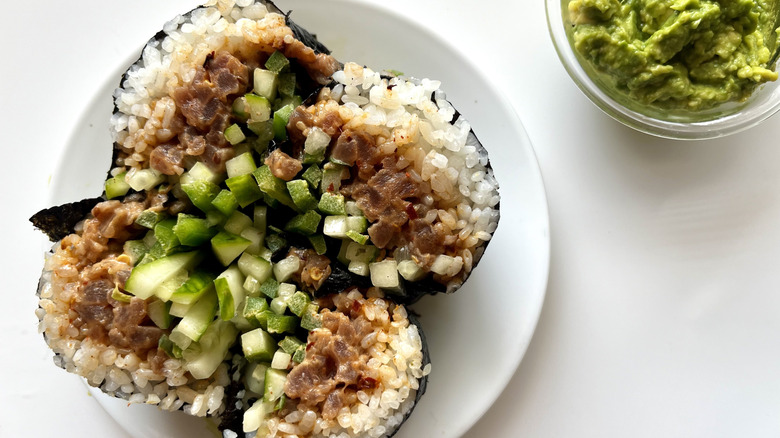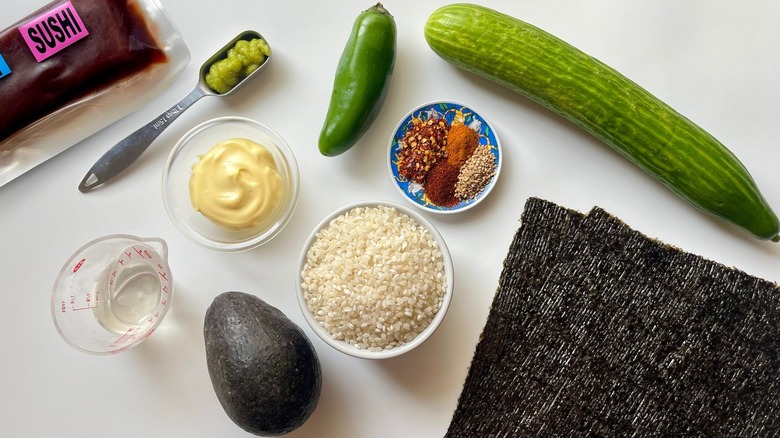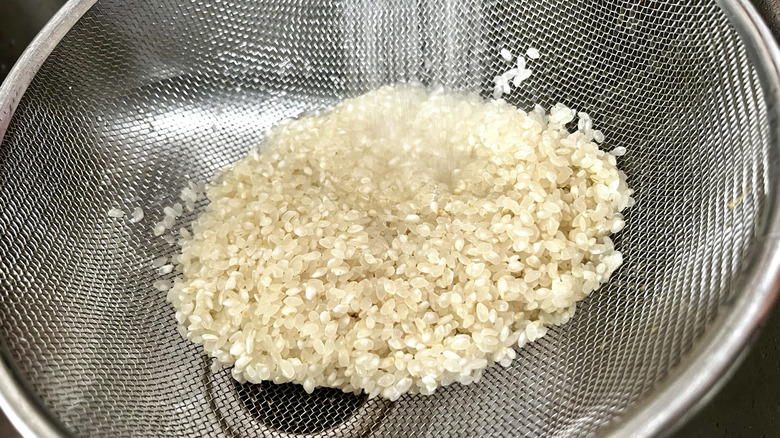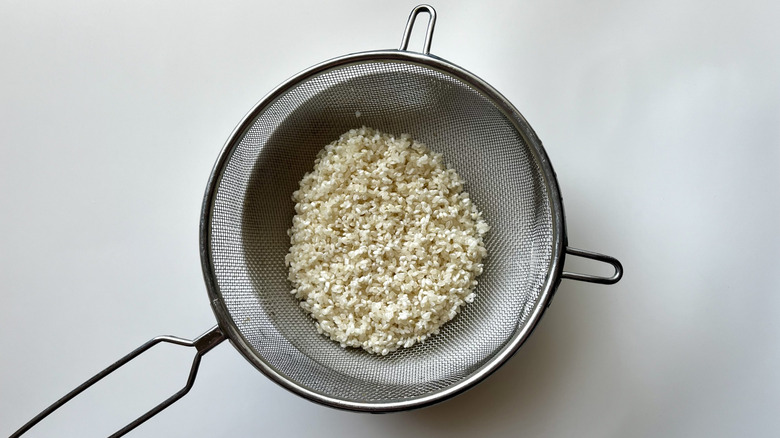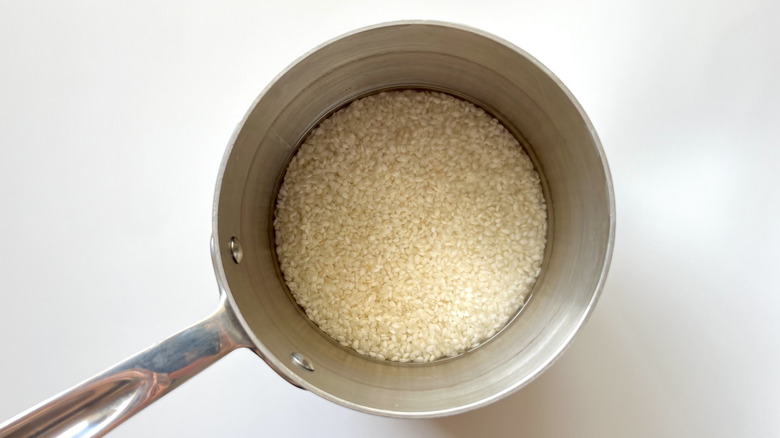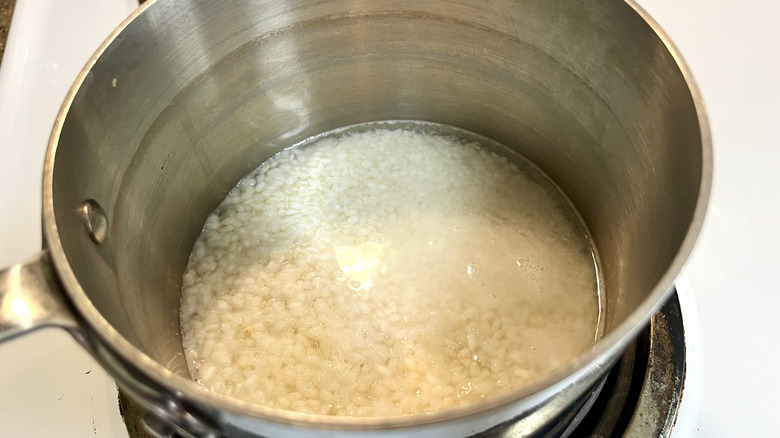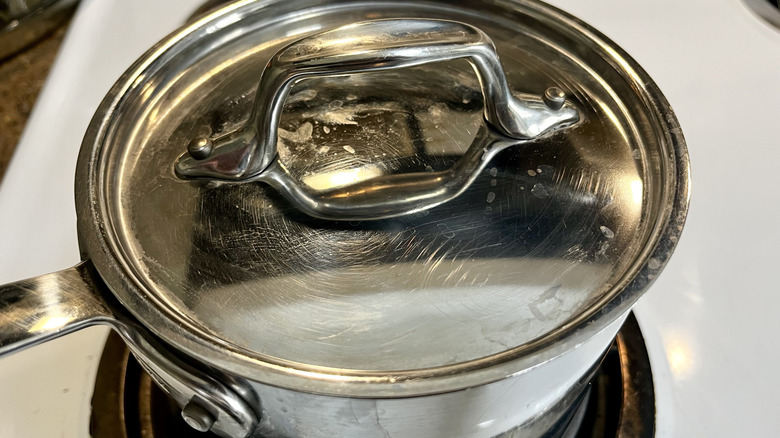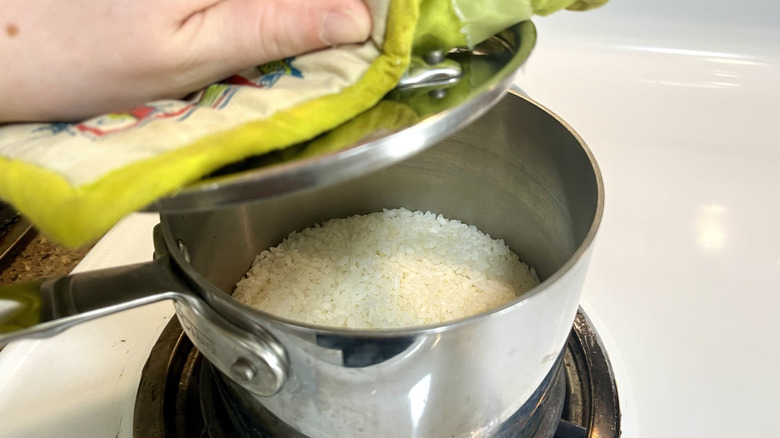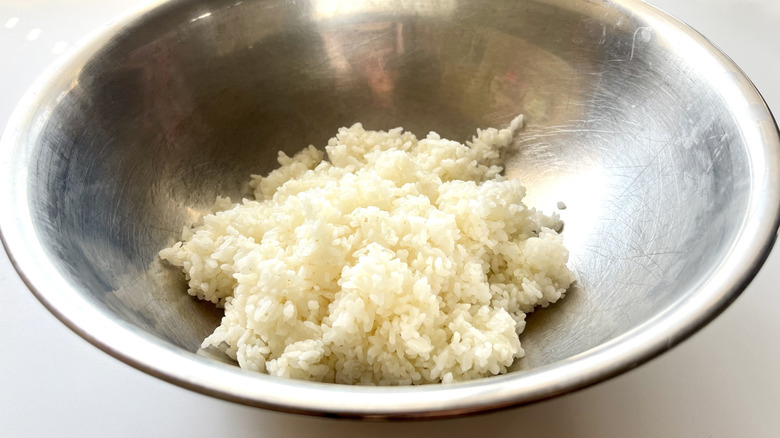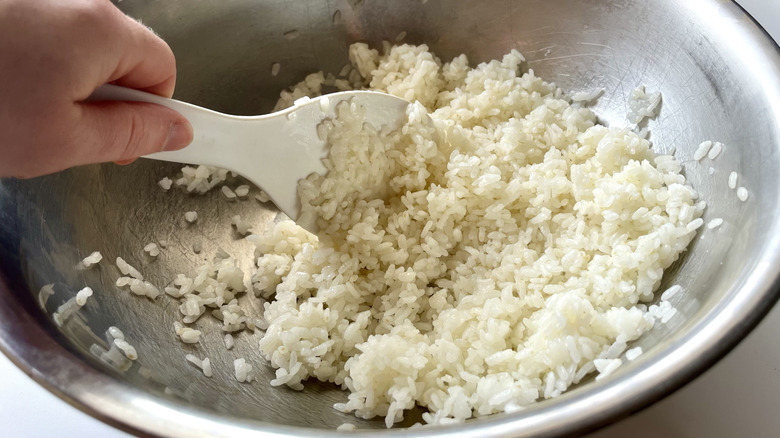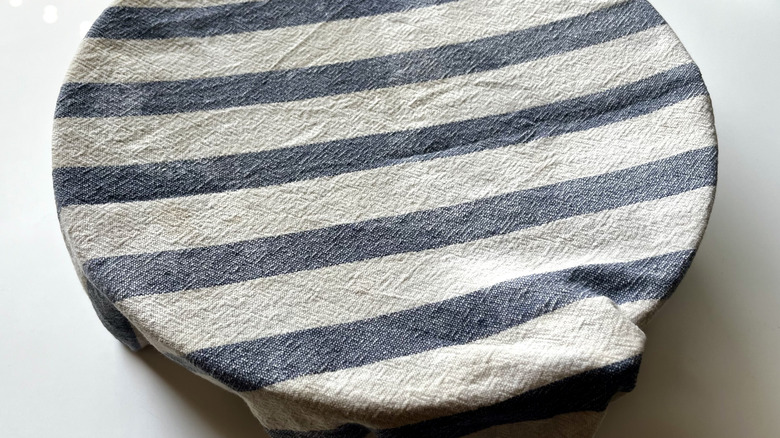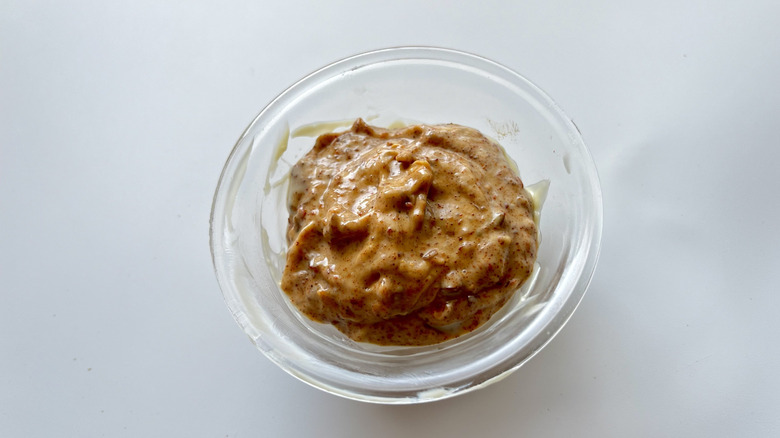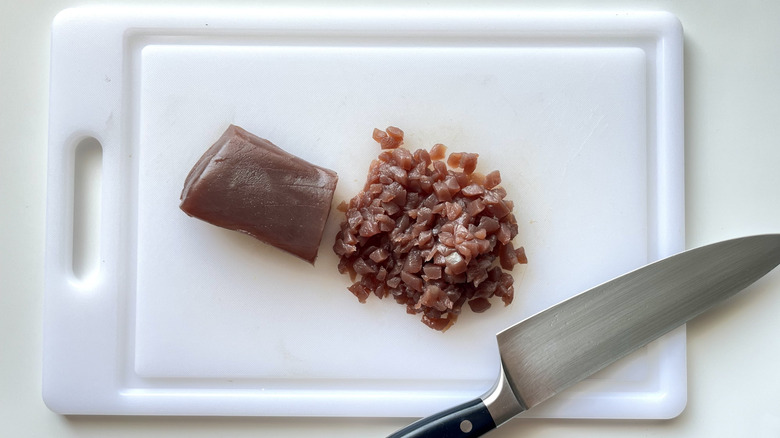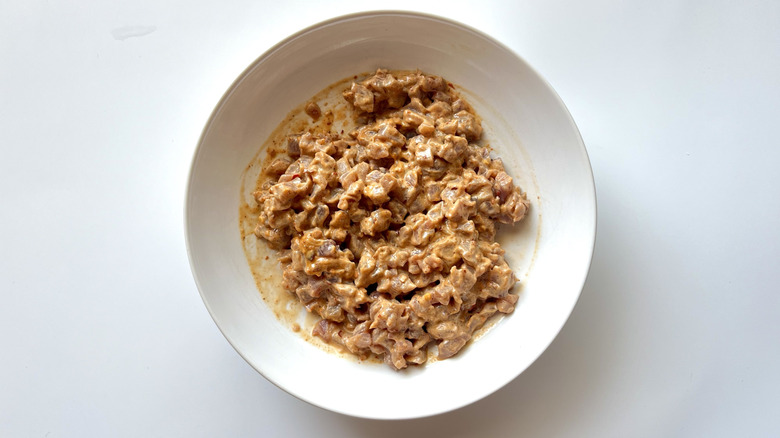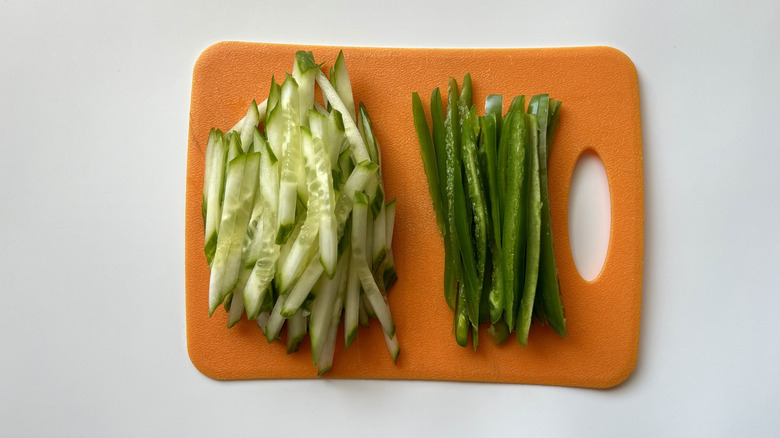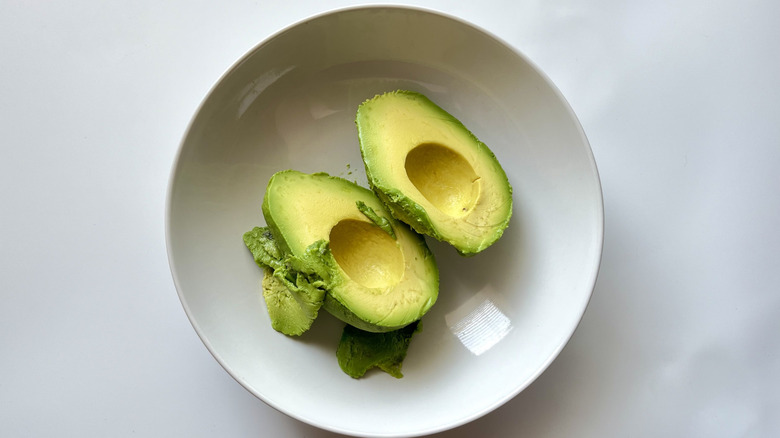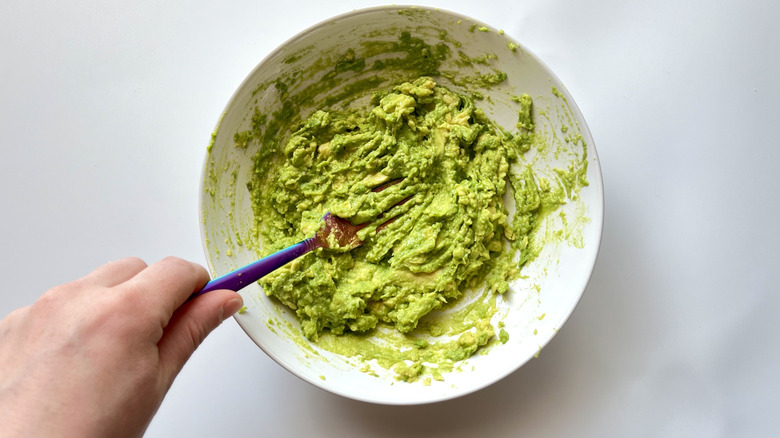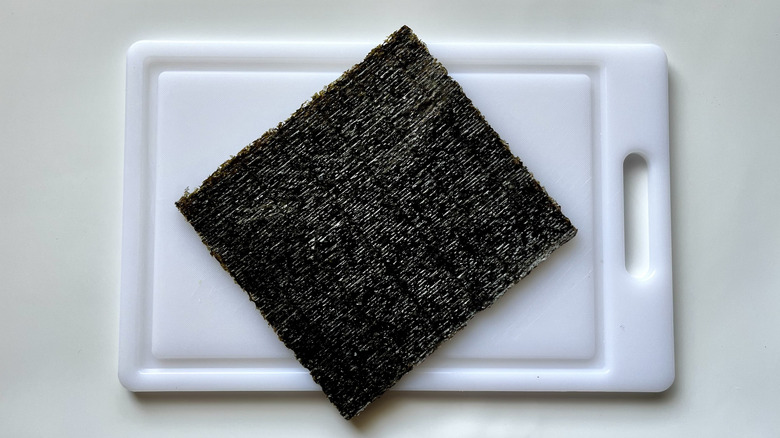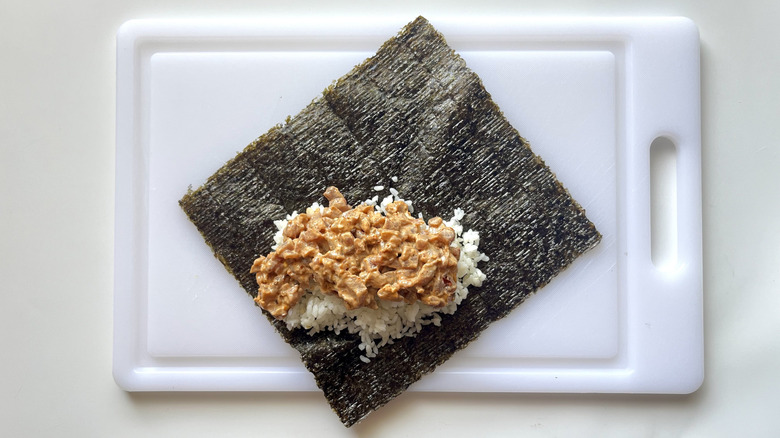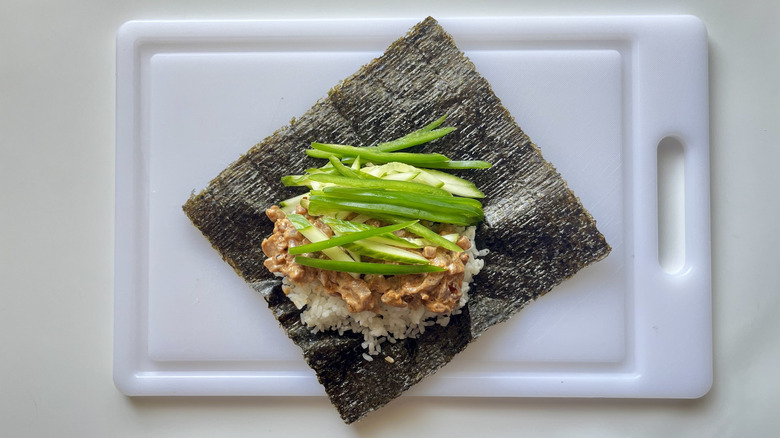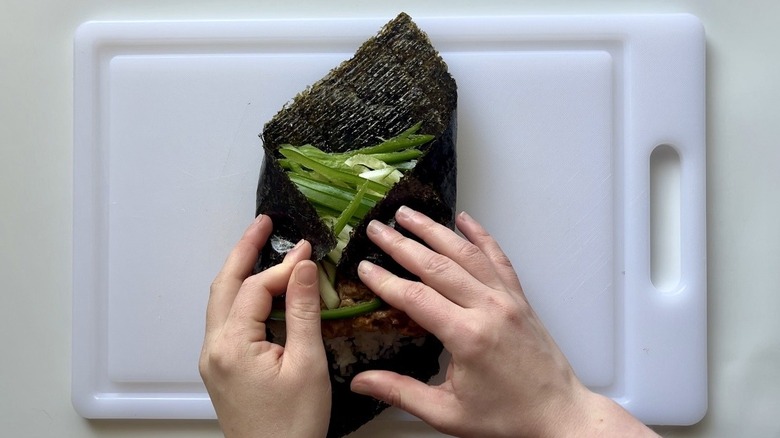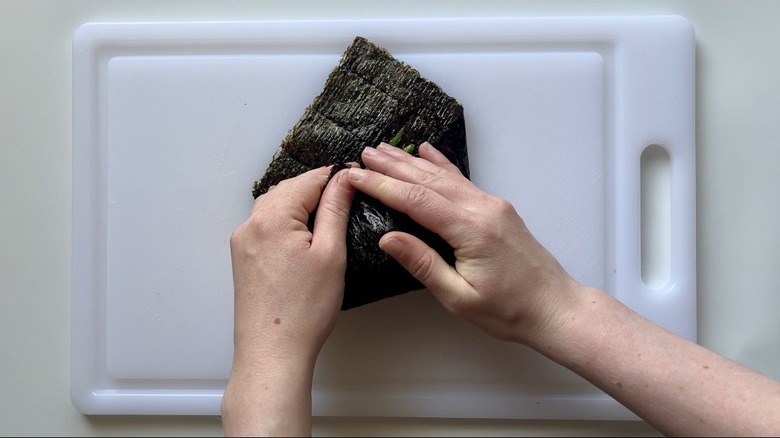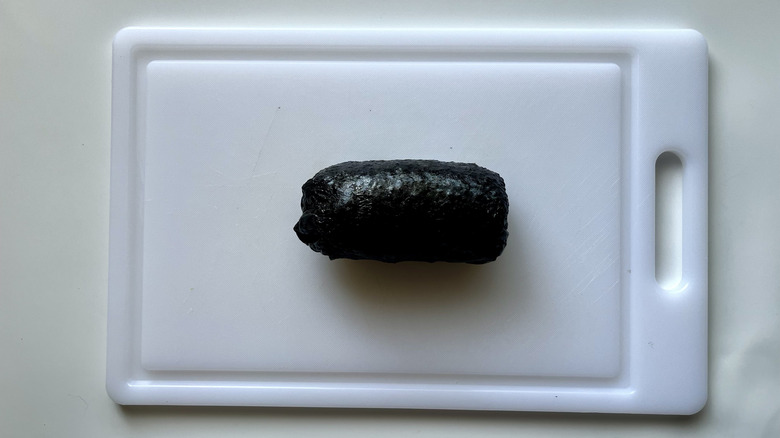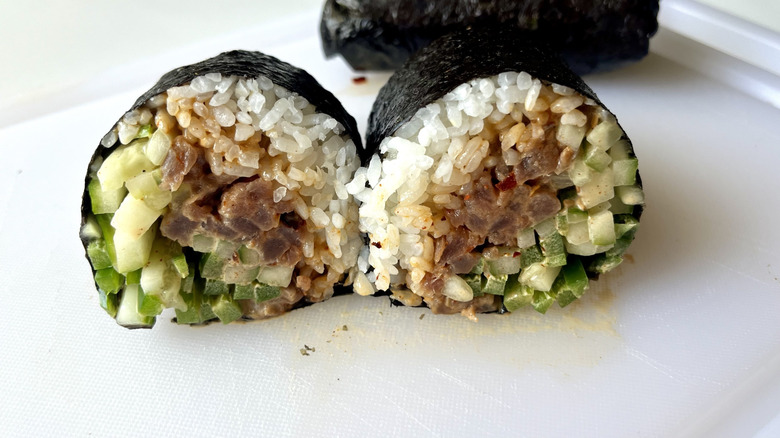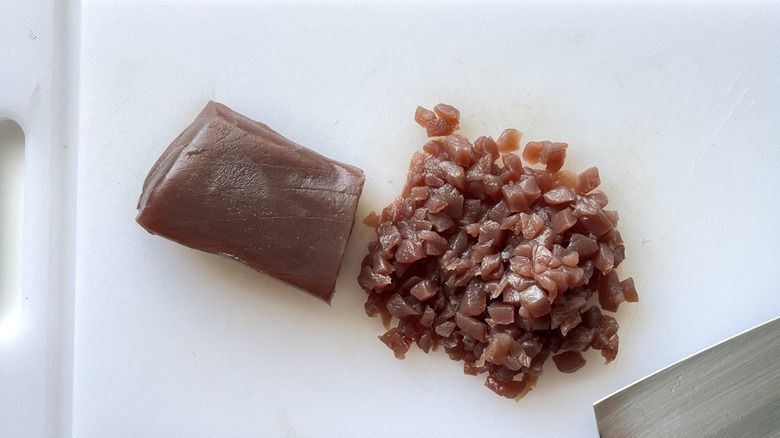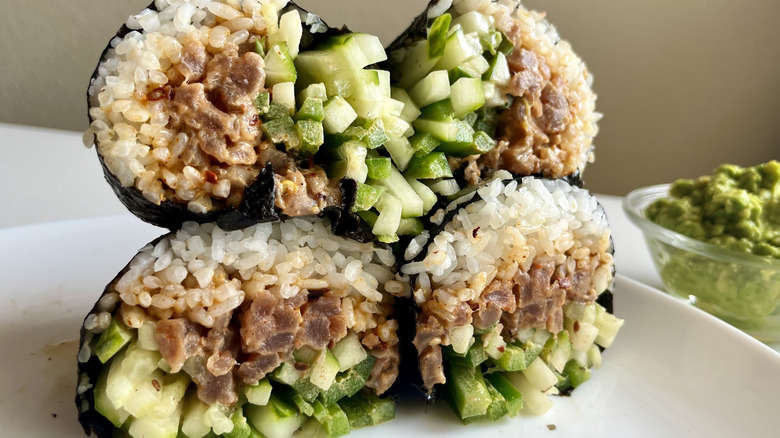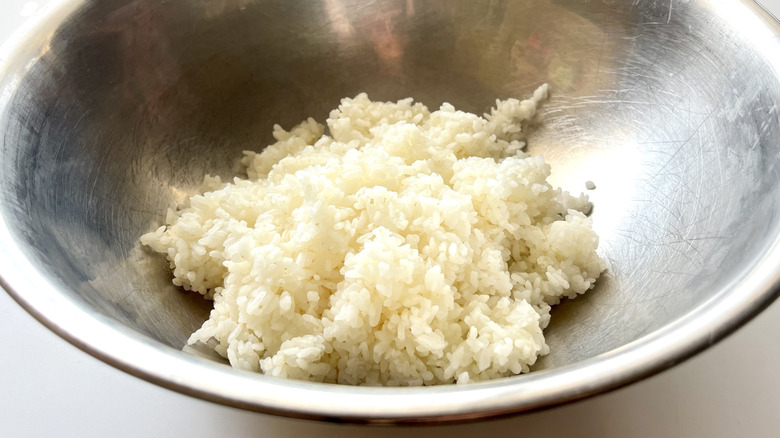Spicy Tuna Sushi Burrito Recipe
Sushi and burritos may sound like two foods that are distinctly different — so much so that you might think they couldn't possibly fuse together into one cohesive dish — but recipe developer Tess Le Moing's spicy tuna sushi burrito proves that even the most unlikely of duos can work together quite well. As Le Moing tells us, "I wanted to make a true food fusion here. It's more like a burrito with ingredients you'd find in sushi, not a giant sushi roll like many other recipes out there have done."
So, what specific elements of sushi and burritos are at play here? Well, for starters, Le Moing uses nori as the "tortilla," wrapping it in the way that a traditional Mexican burrito would be packaged up. The inside of the burrito is where sushi lovers will get excited, with sushi rice, tuna, sliced cucumber, and jalapeño coming together to create a filling that is quite reminiscent of a California roll. And, as if the burrito-like shape and sushi-inspired fillings weren't enough, Le Moing brings two staple toppings of each respective dish — avocado and wasabi — together to create a guacamole with a real kick, and one that adds "a nice creamy richness to the burrito." You can always skip the wasabi and stick with plain guac, and as a matter of fact, just about anything in this sushi burrito is interchangeable based on preference.
Gather the ingredients for this spicy tuna sushi burrito
To kick off your sushi burrito, you'll start with a classic foundation for both sushi and burritos — rice — and more specifically, sushi rice and seasoned rice vinegar. You'll also need sushi-grade tuna along with ingredients for spicy mayo, which include Kewpie mayonnaise, crushed red pepper flakes or gochugaru, chili powder, cayenne pepper, and roasted sesame seeds.
Nori sheets serve as the tortilla-like outer shell of the burritos, and other goodies that go inside include cucumber and jalapeño. All that's left is the wasabi guacamole, which requires just the wasabi itself and some avocado.
Step 1: Rinse the sushi rice
To make the sushi rice, place the rice in a fine-mesh strainer and rinse under cold water until the run-off water runs clear.
Step 2: Let the rice drain and dry
Place the strainer in a bowl and let dry for 5 to 10 minutes.
Step 3: Soak the rice
Transfer the sushi rice to a small pot and add 1 cup of water. Soak for 20 minutes.
Step 4: Begin cooking the rice
Bring the pot of rice to a simmer over medium-high heat.
Step 5: Cover and simmer
Reduce the heat to low, cover, and cook, covered, for 10 minutes.
Step 6: Quickly remove then replace the lid
Remove the lid for 1 second, then put the lid back on and turn off the heat. Let rest for 10 more minutes.
Step 7: Mix the rice with vinegar
Pour the cooked sushi rice into a large bowl along with the seasoned rice vinegar.
Step 8: Fluff the rice
Using a rice paddle or wooden spoon, stir and fluff the rice until there are no large clumps.
Step 9: Cover the rice
Place a clean, damp towel over the bowl to prevent the rice from drying out, and let cool for 20 minutes.
Step 10: Make the spicy mayo
Meanwhile, make the spicy mayo by whisking together all the ingredients in a bowl.
Step 11: Chop the tuna
To start the burrito, finely chop the tuna.
Step 12: Combine the tuna and spicy mayo
Combine the tuna and spicy mayo in a bowl.
Step 13: Julienne the cucumber and jalapeño
Julienne the cucumber. Remove the seeds from the jalapeño and julienne.
Step 14: Begin making wasabi guacamole
To make the wasabi guacamole, scoop out the avocado flesh into a bowl.
Step 15: Add wasabi and mash
Add the wasabi and mash the avocado with a fork to your desired texture.
Step 16: Begin assembling the burrito
To assemble the burrito, arrange 2 sheets of nori on top of each other in the shape of a diamond, rough-side face-up.
Step 17: Add rice and tuna
Slightly dampen your hands with water to prevent sticking, then add ½ cup sushi rice and ½ cup of the tuna-mayo mixture evenly across the center of the nori.
Step 18: Top with vegetables
Top with cucumber and jalapeño.
Step 19: Fold in the sides
Fold the left and right sides of the nori over the filling.
Step 20: Roll the burrito
Roll the bottom flap of nori up over the filling, holding the sides tight as you roll.
Step 21: Finish rolling and seal
Continue rolling until the burrito is sealed. Repeat with the remaining nori and burrito fillings.
Step 22: Halve the sushi burritos and serve
Cut each burrito in half and serve with wasabi guacamole and soy sauce, if desired.
Spicy Tuna Sushi Burrito Recipe
This tuna sushi burrito is a real fusion of flavors, with nori serving as the wrapper for a filling of sushi-grade tuna, crunchy vegetables, and wasabi guac.
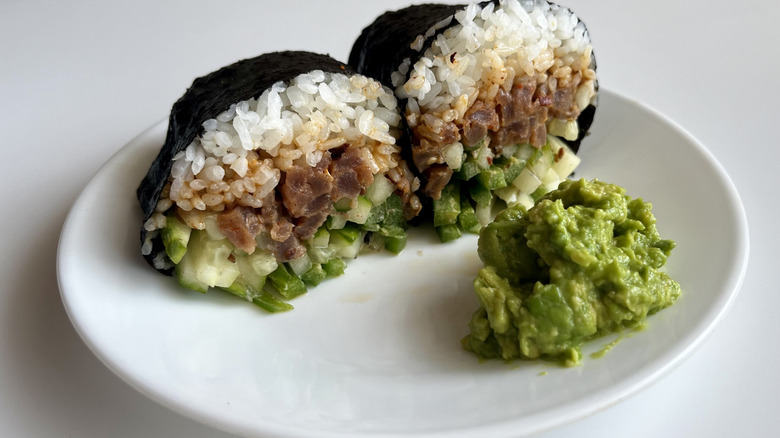
Ingredients
- For the sushi rice
- 1 cup prepared sushi rice
- 2 tablespoons seasoned rice vinegar
- For the spicy mayo
- ½ cup Kewpie mayonnaise
- 2 teaspoons crushed red pepper flakes or gochugaru
- 1 teaspoon chili powder
- 1 teaspoon cayenne
- 1 teaspoon roasted sesame seeds
- For the burrito
- ¾ pound fresh, sushi-grade tuna
- ½ English cucumber
- 2 large jalapeños
- 8 full sheets nori
- For the wasabi guacamole
- 2 avocados
- 2 tablespoons wasabi
Directions
- To make the sushi rice, place the rice in a fine-mesh strainer and rinse under cold water until the run-off water runs clear.
- Place the strainer in a bowl and let dry for 5 to 10 minutes.
- Transfer the sushi rice to a small pot and add 1 cup of water. Soak for 20 minutes.
- Bring the pot of rice to a simmer over medium-high heat.
- Reduce the heat to low, cover, and cook, covered, for 10 minutes.
- Remove the lid for 1 second, then put the lid back on and turn off the heat. Let rest for 10 more minutes.
- Pour the cooked sushi rice into a large bowl along with the seasoned rice vinegar.
- Using a rice paddle or wooden spoon, stir and fluff the rice until there are no large clumps.
- Place a clean, damp towel over the bowl to prevent the rice from drying out, and let cool for 20 minutes.
- Meanwhile, make the spicy mayo by whisking together all the ingredients in a bowl.
- To start the burrito, finely chop the tuna.
- Combine the tuna and spicy mayo in a bowl.
- Julienne the cucumber. Remove the seeds from the jalapeño and julienne.
- To make the wasabi guacamole, scoop out the avocado flesh into a bowl.
- Add the wasabi and mash the avocado with a fork to your desired texture.
- To assemble the burrito, arrange 2 sheets of nori on top of each other in the shape of a diamond, rough-side face-up.
- Slightly dampen your hands with water to prevent sticking, then add ½ cup sushi rice and ½ cup of the tuna-mayo mixture evenly across the center of the nori.
- Top with cucumber and jalapeño.
- Fold the left and right sides of the nori over the filling.
- Roll the bottom flap of nori up over the filling, holding the sides tight as you roll.
- Continue rolling until the burrito is sealed. Repeat with the remaining nori and burrito fillings.
- Cut each burrito in half and serve with wasabi guacamole and soy sauce, if desired.
Nutrition
| Calories per Serving | 527 |
| Total Fat | 38.2 g |
| Saturated Fat | 5.7 g |
| Trans Fat | 0.0 g |
| Cholesterol | 44.4 mg |
| Total Carbohydrates | 23.4 g |
| Dietary Fiber | 8.0 g |
| Total Sugars | 1.6 g |
| Sodium | 236.6 mg |
| Protein | 24.9 g |
What is sushi-grade tuna, and why is it important to use in recipes like a sushi burrito?
Those who enjoy sushi often likely know that not just any type of fish will do the trick — sushi-grade fish is the go-to when it comes to raw consumption. That said, there are certain myths that surround sushi-grade fish, and as it turns out, the real qualifying factor to make fish sushi-grade involves it being frozen before consumption, which will kill any possible parasites. Fortunately, most types of tuna are not likely to harbor parasites, making the type of fish one of the absolute best for eating raw.
All of this said, Le Moing still uses sushi-grade tuna for this burrito and recommends that you do the same. "Sushi-grade tuna is handled, processed, and stored in a way that makes sure is safe to eat raw," she explains. "It's flash-frozen shortly after being caught." The freezing guarantees that any potentially harmful bacteria are killed, and as an added bonus, Le Moing notes that "This type of tuna is also better quality, with a soft and buttery texture." Sushi-grade fish will be labelled as such at the grocery store, and you may be surprised to find that even your local grocers might have some available. Otherwise, a good bet is to go to a fishmonger so you can find exactly the type of fish that you're looking for.
What are some variations or substitutions for ingredients in a sushi burrito if I don't like raw fish or spicy foods?
We've already touched on the fact that this sushi burrito is very customizable, and perhaps one of the easiest things you can swap out is the protein. For starters, you can simply opt for cooked tuna instead of raw, or you can go with other seafood variations like shrimp or salmon. Le Moing notes that plant-based options, like marinated tofu or tempeh, also work well in the burritos.
Another easily customizable element of this burrito is the spicy mayo. Don't have Kewpie mayo on hand? Simply swap it out for regular mayonnaise. Adjust the spiciness of your mayo by altering the amounts of chili powder or cayenne that you add, or simply omit the spice mixture and use something like Sriracha to add a kick of heat instead.
Finally, this recipe uses sushi rice because, well, this is a sushi burrito. That said, you aren't limited to just sushi rice, and you can use other short-grain varieties, white or brown, instead. Le Moing does advise to avoid long-grain rice, like basmati or jasmine, because the texture is too different and these types of rice won't provide that desired stickiness.
How do I make sushi rice in a rice cooker?
The process of making a sushi burrito is a simple one, really, especially because the fish doesn't involve any cooking. If there is one rather involved process in the whole dish, it revolves around the sushi rice — but if you have a rice maker, you can simplify things significantly. "Once you've rinsed the rice in a fine mesh sieve until water runs clear, place equal parts sushi rice and water in the bowl of your rice cooker," Le Moing advises, then proceed to soak the rice as the recipe calls for. The soaking step is technically optional if you're using a rice cooker, but it will ultimately give your rice a more uniform texture.
After soaking, place the lid on your rice cooker, turn it on, and choose either the white rice or sushi rice setting. "Then let the cooker do its job," Le Moing advises. "Once done, let the rice sit in the cooker for 10 minutes with the lid on." After that, you're good to follow the recipe as written.
